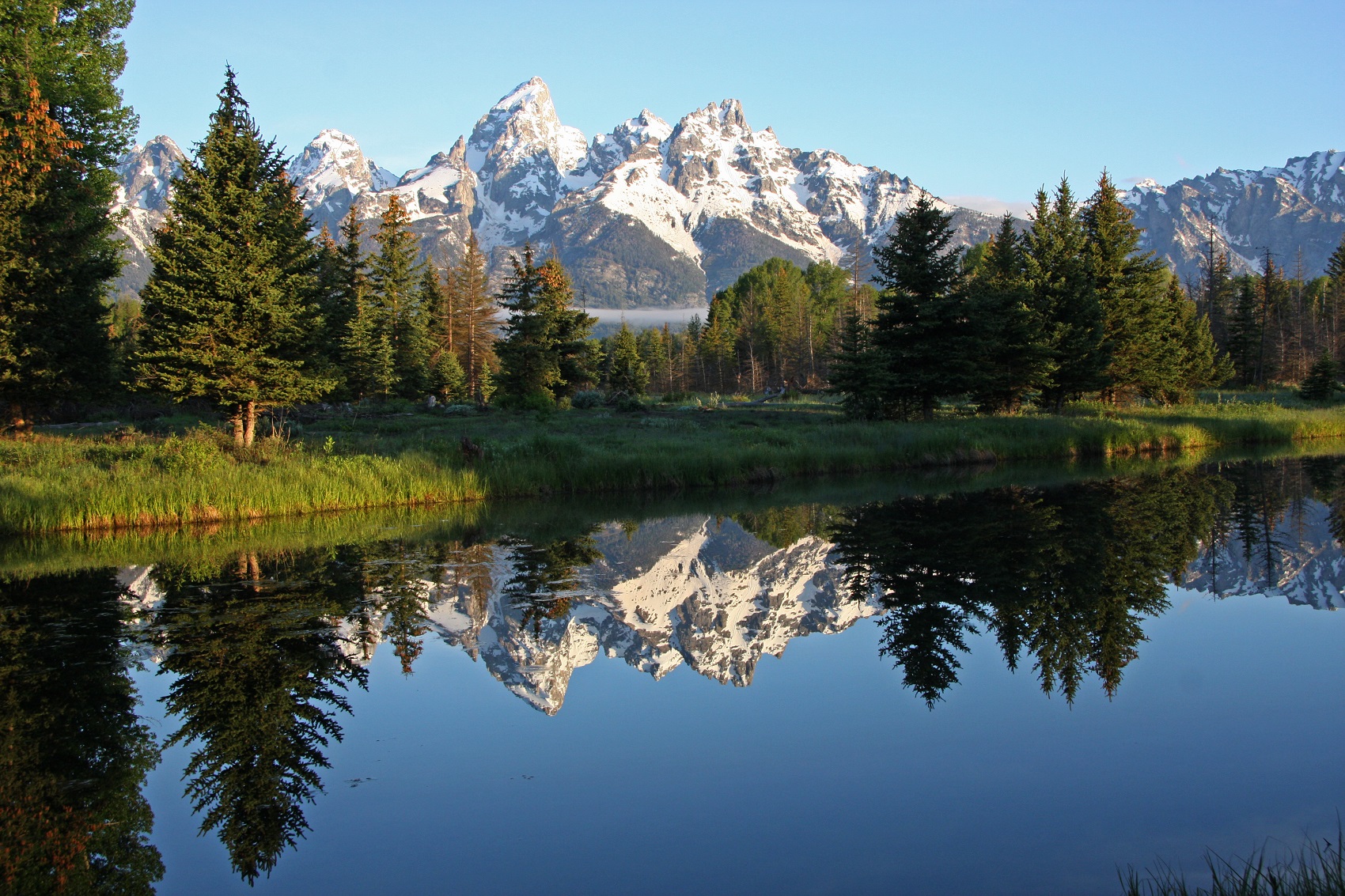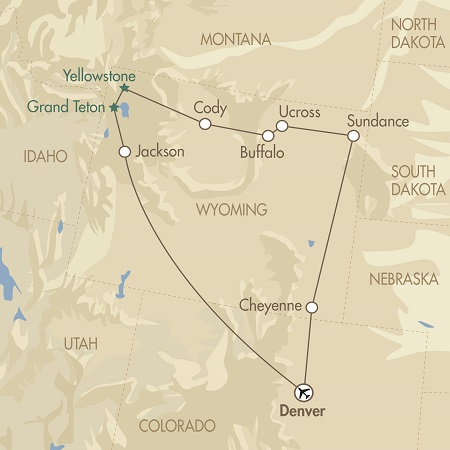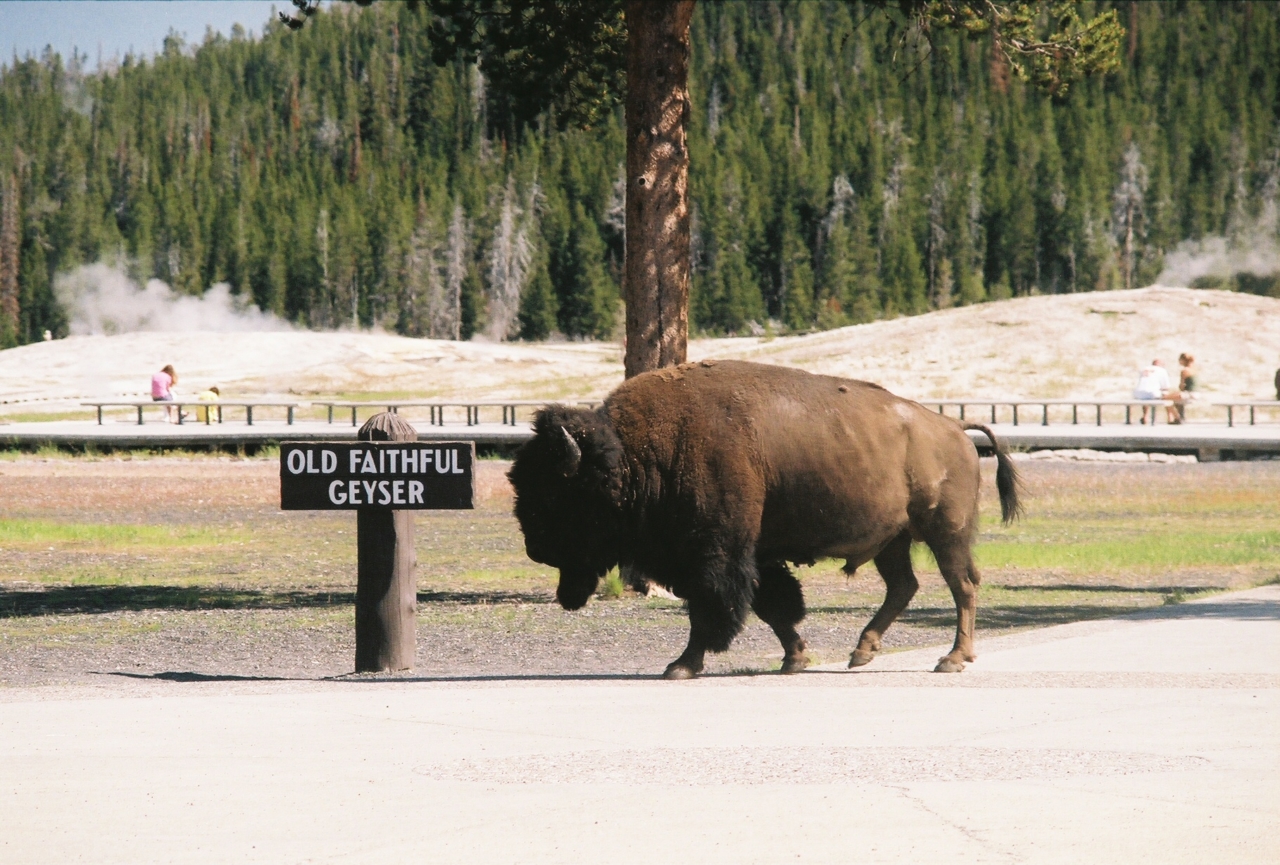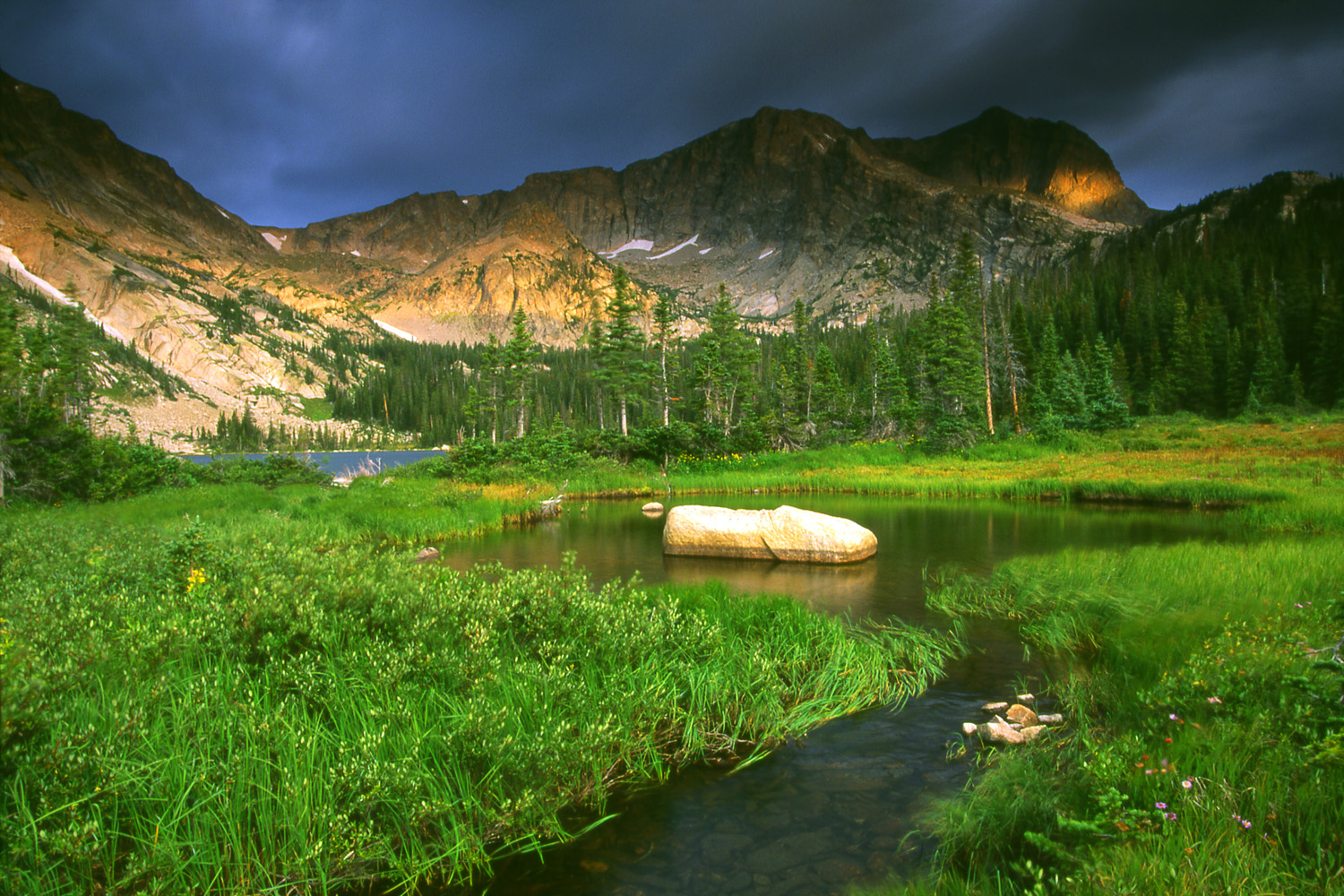Day 1
Arrival at Denver
Depart London Heathrow – 16:05
Arrive Denver – 18:45
Journey Time – 9 hours 40 minutes
The largest city in a 1,000-km circle and the gateway to the Rocky Mountains. Denver is the natural starting point to visit the scenic and historic mountain states, filled with national parks, abundant wildlife, ancient Indian rock art and
much, much more.
Overnight – Denver
Day 2
Denver to Cheyenne
102 miles
It’s almost a straight shot north from Denver to Cheyenne, WY The “Magic City of the Plains” is located at the intersection of Interstates 25 and 80 in southeast Wyoming – in the heart of the American West. Cheyenne is approximately 100 miles north of Denver, Colorado. The name itself speaks of colourful legends and abundant history. It’s also the capital of Wyoming. Visit the Cheyenne Frontier Days Old West Museum & Store, the Cowgirls of the West Museum or the F.E. Warren Air Force Base Museum or the Wyoming State Capitol Building & Grounds, a National Historic Landmark with gleaming marble floors, beautiful woodwork and lots of stained glass. Take a ride in the Cheyenne Street Railway Trolley go on a Historic Downtown Walking Tour. Cheyenne is Western History at its best.
Overnight – Cheyenne
Day 3
Cheyenne to Sundance
312 miles
Visit Fort Laramie (originally founded as Fort William and then known for a while as Fort John), a significant 19th century trading post and diplomatic site located at the confluence of the Laramie River and the North Platte River. The evening finds you in Sundance, named for the Sun Dance ceremony practiced by several North American Indian Nations. A sign visible from I-90 proclaims that Sundance is “where the kid got his name.” After his release from the Sundance Jail in 1888, Harry Longabaugh acquired the moniker the Sundance Kid, which entered the popular imagination in the 1969 movie Butch Cassidy and the Sundance Kid!
Overnight – Sundance
Day 4
Sundance to Devil’s Tower to Ucross
149 miles
Visit Devil’s Tower. President Teddy Roosevelt designated Devils Tower as the nation’s first national monument in 1906. The tower is actually a volcanic neck over 860 feet high. Film director Steven Spielberg used the Devils Tower location as a landing pad for aliens in his 1978 movie, “Close Encounters of the Third Kind.” Nearby the Vore Buffalo Jump has been deemed one of the world’s premier archaeological sites. Dig teams are on the job during the summer and the public is welcome to walk down into the natural sinkhole where layers of bison bones are still intact. The Plains Indians are believed to have stampeded up to 20,000 shaggy bison over the rim near the site. Then check in at the Ranch at Ucross for the next two nights!
Overnight – Ucross
Day 5
Ucross
Ucross and its surrounding area is rich in the history of the west. Many western writers, sculptors, artists and craftsmen make this area home for just that reason. Friendly staff, gentle horses, beautiful scenery, and big fish can be found at the Ranch at Ucross. As you stand outside the Ranch House and contemplate the amazing cottonwood and pine trees, it may occur to you that this is the most beautiful country you have ever seen. Cast your fly into Piney Creek. Play a set or two of tennis in the afternoon. Whatever your pleasure, from hiking in the foothills of the Big Horn mountains, horseback riding (1 ride per day, approx. one hour), swimming or skeet shooting; to relaxing with a game of horseshoes, there is no lack of activities. After all this activity you’ll want to relax by a warm fire in the living room of the historic Ranch House.
Overnight – Ucross
Day 6
Ucross to Sheridan to Buffalo
18 miles
Visit Sheridan, which appeared on Newsmax magazine’s 2009 list of the “Top 25 Most Uniquely American Cities and Towns,” a piece written by current CBS News travel editor Peter Greenberg. In the cover story, Greenberg called Sheridan “the real deal” and praised it for preserving “its rich American history.” Spend some time exploring Sheridan’s Main Street Historic District. The city was named after General Philip Sheridan, Union cavalry leader in the American Civil War. The city is also only a short distance away from the site of the Battle of Little Bighorn, in which General Custer was killed. The little town of Buffalo, today’s final destination, is located on the historic Bozeman Trail and proxy to numerous Indian Battlefields and historic western sites like Fort Phil Kearny State Historic Site, where Lakota and Cheyenne Indians fought to keep their last great buffalo hunting grounds.
Overnight – Buffalo
Day 7
Buffalo to Big Horn Mountains to Cody
268 miles
Today you can pick from equally scenic routes that will lead you to Cody. Big Horn Scenic Byway passes geological formations named Buffalo Tongue, the Fallen City and Steamboat Point before reaching Burgess Junction and 9,000′ Granite Pass. The spectacular drive down Shell Canyon is highlighted by a stop at Shell Falls. Medicine Wheel Passage begins at Burgess Junction and follows the Tongue River to its headwaters before crossing to the west side of the Big Horns at near-timberline elevations. The road passes within a few miles of the Medicine Wheel, built in pre-historic time by unknown people who departed the scene long before the first Plains Indian Tribes arrived. Make sure you have time left to experience Cody, a picturesque little western town, gateway to Yellowstone National Park. During the summer months, you can enjoy a nightly rodeo, visit Buffalo Bill Historical Centre which is widely regarded as America’s finest Western museum, get a feel for the Old West while watching a “shoot-out” in front of the historic Irma Hotel or experience “Old Trail Town”.
Overnight – Cody
Day 8
Cody
Spend the day exploring Cody. We recommend an early morning (guided) Wild Mustang Tour, considered one of the premier Wild Horse Tours in America today… To stand in the open prairie and observe the true behaviour of a wild mustang in its natural habitat is an experience you will never forget!” ~ Ken Martin ~ During your 2 to 2 1/2 hour trip you may have the opportunity to view Pronghorn Antelope, Golden Eagles, Coyotes and Black tailed Prairie Dogs and of course your guide will be on the look-out for wild horses! There is so much to see and do in Cody – your day will be over before you know it!
Overnight – Cody
Day 9
Cody to Yellowstone National Park
316 miles
Again – choices, choices, choices! Beartooth Highway Scenic Byway is, perhaps, North America’s most spectacular alpine highway. This above-timberline drive takes travellers among towering peaks and glacier-fed lakes, then into the beautiful Clark’ s Fork Valley, dominated by Pilot and Index Peaks, before reaching Yellowstone’s northeast Silver Gate. Chief Joseph Scenic Highway leads over Dead Indian Hill, switchbacks down into Sunlight Basin and then follows the Clark’s Fork River to a junction with the Beartooth Scenic Byway. The road follows the escape route used by Chief Joseph and the Nez Perce tribe as the U.S. Army pursued them. The most direct route is the Buffalo Bill Cody Scenic Byway which follows the North Fork of the Shoshoni River west from Cody. Buffalo Bill, Cody’s founder and namesake, called this road, “The most beautiful 50 miles in the world.” The highlight of today is of course Yellowstone National Park The nation’s first national park still remains primarily a wilderness with 97 percent of the park’s 3,400 square miles (2.2 million acres) remaining undeveloped. While Old Faithful, the most widely recognized geyser, serves as the park’s signature steam, there are more than 10,000 other geothermal features in Yellowstone including geysers, hot springs, mud pots and fumaroles.
Overnight – Yellowstone National Park
Day 10
Yellowstone National Park
A day to explore the wonders of the park (we recommend pre-booking a guided bus tour of the park).
Overnight – Yellowstone National Park
Day 11
Yellowstone National Park
Another day to explore the wonders of Yellowstone National Park!
Overnight – Yellowstone National Park
Day 12
Yellowstone National Park to Grand Teton National Park
66 miles
Today take your time to explore Grand Teton National Park, one of the ten most visited national parks in the U.S. Most of the lakes in the park were formed by glaciers and the largest of these lakes are located at the base of the Teton Range. In the northern section of the park lies Jackson Lake, the largest lake in the park at 15 mi (24 km) in length, 5 mi (8.0 km) wide and 438 ft. (134 m) deep. Grand Teton National Park and the surrounding region host over 1000 species of vascular plants. With an altitude variance of over 7,000 ft. (2,100 m), the park has a number of different ecological zones including alpine tundra, the Rocky Mountains subalpine zone where spruce-fir forests are dominant, and the valley floor, where a mixed conifer and deciduous forest zone occupies regions with better soils intermixed with sagebrush plains atop alluvial deposits. Sixty-one species of mammals have been recorded in Grand Teton National Park. This includes the grey wolf, which had been extirpated from the region by the early 1900s but migrated into the Grand Teton National Park from adjacent Yellowstone National Park after the species had been reintroduced there.
Overnight – Grand Teton National Park
Day 13
Togwotee to Jackson
46 miles
Jackson Hole is surrounded by lakes, some of them of considerable size, and traversed by the beautiful Snake River. Popular leisure activities are hiking, fishing, canoeing and for the experienced some challenging climbing routes. In winter there is a wide variety of sports including downhill and cross-country skiing, skating, dog-sledding, ice fishing etc. This well watered mountain valley is the home of elk, wapiti and mule deer; on the lakes and rivers there are beavers, trumpeter swans, white pelicans, wild ducks, wild geese and ospreys; and a heard of bison is usually to be seen grazing to the east of the Oxbow Bend on the Snake River. Black bears are now rare. Or you take the scenic route along the western edge of Yellowstone N.P. Either way – the afternoon will find you in Jackson, a quaint little Western town surrounded by beautiful scenery. A visit to Jackson is not complete without a stop in the Million Dollar Saloon!
Overnight – Jackson
Day 14
Jackson to Casper
280 miles
At the edge of the Rocky Mountain Range you will pass through Riverton, part of the Wind River Indian Reservation, shared by the Eastern Shoshone and Northern Arapaho tribes of Native Americans, the seventh-largest Indian reservation by area in the United States. The evening finds you in Casper, nicknamed “The Oil City” with a long history of oil boomtown and cowboy culture, dating back to development of the nearby Salt Creek Oil Field.
Overnight – Casper
Day 15
Casper to Denver
278 miles
Today you can take the quick route, hoping on the freeway straight back to Denver which will give you some time to explore Denver – or you can take the more scenic route. The land now known as Medicine Bow National Forest has a long history, reaching back as far as 8,000 years when ancestors of the Plains Indians inhabited the area. The Northern Arapaho, Oglala Sioux, Northern Cheyenne, Eastern Shoshone and the White River Utes all frequented the area. Soothing mineral hot springs along the banks of the North Platte River provided a welcome place to “make medicine” to cure their ills and hold ceremonial powwows. You can still visit at least one of those springs today, in the town Saratoga. Admission to the public hot springs is free. Then continue along the Snowy Range Scenic Byway which crosses the Medicine Bow Mountain Range. Approachable from the west or east, the Byway route rises from 8,000 ft. on the valley floor to a height of 10, 847 ft. above sea level. But either way leave some time for Denver’s Larimer Square, a restored section of Denver’s oldest street, with great restaurants and pubs, to bring this trip to a great ending!
Overnight – Denver
Day 16
Depart Denver
Enjoy a day in Denver before flying home in the evening.
Depart Denver – 20:40
Arrive London Heathrow – 12:45 (Next Day)
Journey Time – 9 hours 5 minutes
























